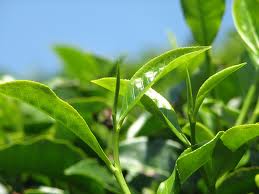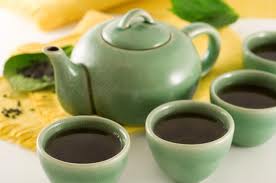An extraordinary characteristic of green tea, as with many of the other five classes of tea, i.e., Yellow, White, Oolong, Black, and Pu-erh, is that it has several “subcategories” with varying tastes and aromas. The subcategories come about by unique differences in tea growing regions; climate and soil do much to change tea properties, which in turn change the characteristics of the tea. Differences are also brought about through artistic variances in manufacturing the tea leaves into the green tea we purchase in the marketplace.
Thousands of green tea varieties (last I heard it was over 3,000) are available in the market today, and many people do not realize that one cup of green tea could be very different than another cup. To many, green tea is green tea and that’s all there is to it. But having a little knowledge about the different processing styles of green tea, and trying each of them, will help us better find the green tea that is most satisfying to us.
And a good way to gain this knowledge is to look at the different manufacturing processes of green tea. Writing about the vast differences in growing regions, as you might imagine, could take on book-size dimensions, so I’ll instead focus here on the different manufacturing processes, specifically the primary drying processes, which create subcategories of green tea.
The Manufacturing of Green Tea

Green Teas
As with all classes of tea, green tea starts its life as a bud on the Camellia Sinensis. Most green tea is produced in different mountainous regions of China and Japan where they have been growing tea for 4000 years. Needless to say, they know what they are doing and they’ve had significant time to get artistic about turning it into tea. What a tea master does with the tea leaf gives it an artistic distinction. Making tea is a form of art in itself, and good quality tea is produced by tea experts.
Any tea goes through the first stages of plucking, sorting, and cleaning. But then, three styles of green tea manufacturing are distinguished by the primary, or initial, drying of the tea leaves. The purpose of the primary drying is to retard any oxidation from occurring to the leaves, but the drying is also given credit for creating a distinctive edge or subcategory of green tea.
The first few processing steps are the same for most green teas:
- Trained tea pluckers climb the mountains to pick fresh green tea leaves in the morning hours during harvest season, which for example, in China is March thru May, and in Japan is May thru August. Dormant seasons are December thru mid-February and September thru Aril, respectively.
- The leaves are carefully loaded in baskets or cloth bags that provide air circulation, and are not too densely loaded so as to protect them from being bruised or crushed.
- Leaves are then sorted to remove twigs and rocks; this is sometimes done at the mountain growing site, or the leaves are carried down the mountain first and then sorted.
- Once at the manufacturing site, the drying process begins.
The 3 primary drying styles are:
1. Sun-dried
2. Basket-fired
3. Pan-fired
Sun-dried Green Tea
This is the most traditional and basic technique of primary tea processing. Sun-drying is an easy, straightforward and effective method used in primary drying. While modern technology can produce quicker tea drying methods (as in an oven-dried tea), tea masters wishing to continually produce the best quality of tea possible, use the “hands-on” approach to making green tea.
Freshly plucked tea leaves are laid out on mats, about 2 to 5 inches deep, in the open air in a dry, breezy, partially sunny (some shading is desirable) location. They are periodically flipped, tossed or shaken to change the position of the leaves, and in doing so, create a uniform drying of the leaves. It’s a lengthy, controlled process, and is best done in growing regions with generally predictable weather of low humidity, dry breezes, and clear skies, such as is found in China’s mountainous provinces of Yunnan, Sichuan, and Anhui, or in the Darjeeling region of India.
The fresh leaves sit in the sun until moisture evaporates from them down to a level of 60-70% depending on the processors intended results. This primary drying can take from a few minutes to more than an hour, depending upon the moisture in the leaf, the time of day, and the air temperature and humidity. Sun-dried tea is typically made from the leaves of mature (ancient) plants that tend to have less moisture content than younger plant, making sun-drying more feasible.
The tea leaves are then moved to the finishing fire stage of tea processing.
Sun-dried green tea is very green in color, carries a natural grassy or earthy flavor, and tends to be bulkier in volume, as no application of weight pressing or twisting is used in its processing.
Basket-fired Green Tea
In this drying technique, a small amount of freshly picked leaves, no greater than 2.2 lbs. are placed in the top part of a 2-part, 2 to 4 foot tall (and wide) bamboo basket construction – modern adaptations are made of metal.
The whole basket, open on the bottom half, is manned by two tea workers and set over a small brazier of hot, glowing charcoal. They leave the basket over the charcoal embers for approximately one minute, at which time they remove the entire basket and “fluff” the tea, tossing it gently to change the position of the leaves, again for uniformity in drying. The whole process of firing and fluffing is repeated for approximately 15 to 20 minutes. An interesting note about this process is that the upper part of the basket takes up the heat from the leaves, deteriorates quickly, and is replaced every 2 to 3 days.
The purpose of the basket-fried method of drying is to coax the leaves into a relaxed condition so that they can be shaped into a unique form, such as twisted or rolled.
The tea is then placed on a mat with other leaves already basket-fired to settle (perhaps to even air dry a bit, again depending on the tea master’s intentions) before being finish-fired.
Green tea dried in this fashion typically has a full-flavor that can be reminiscent of grass, minerals, a hint of charcoal, or a combination. The tea leaves are bulky and shaped, twisted, rolled, etc. in appearance. An example of this tea is called Green Snail Spring (aka Bi Lo Chun or Pi Lo Chun from the prosperous Jiangsu Province of China.
Pan-fried Green Tea
This is sort of the “one-step accomplishes all” method of drying of tea leaves, and is done with both fresh leaves and primarily dried leaves. In this one process, moisture is driven out of the leaf to the desired content before finish firing and flavor is sealed in with a special roasted taste.
A variety of pan styles (and variations of method, for that matter) is used for this drying method, but two common versions used in China are a doubled wood-fired pan and a single electric-fired pan.
The tea leaves of approximately 2.2 lbs. are placed in the pan to dry in consistent heat, which reduces the volume of the leaves by a 4 to 5 factor. Tea workers continually press the tea leaves against the tea pan so they retain contact with the heat of the pan. As a result, the finished tea is typically compressed and fine in appearance.
A great and perhaps unmatched example of pan-fried tea is Dragon Well (aka Longjing) from the Zhejiang Province of China. Some experts will say that Dragon Well is the epitome of pan-fired green tea, smooth in appearance, flat and sword shaped, and terroir induced, unique flavor.
Finish Fired Green Tea

Green Teas
After any of the primary drying methods, tea leaves are typically “finish-fired”, an important step in bringing the tea to a final condition of dryness by removing excess moisture left in the leaves, to the extent desired by the tea maker. It is the final step in tea manufacturing that also seals or finishes the leaf, giving it stability for the marketplace.
Finish-firing is often done in a rotary-drum oven, baking oven, or charcoal-fired. Any way that it is done, final firing, just like primary firing is a very controlled process.
This article gives a simplistic idea of how different methods of tea production can result in different varieties of green tea with different tea properties. With each one of these processes, comes a unique spin or way of doing things based on the area producing the tea and the tea master. It’s fun to try different types of tea, particularly when you know a bit about the methods of producing it that give way to a unique aroma or taste.